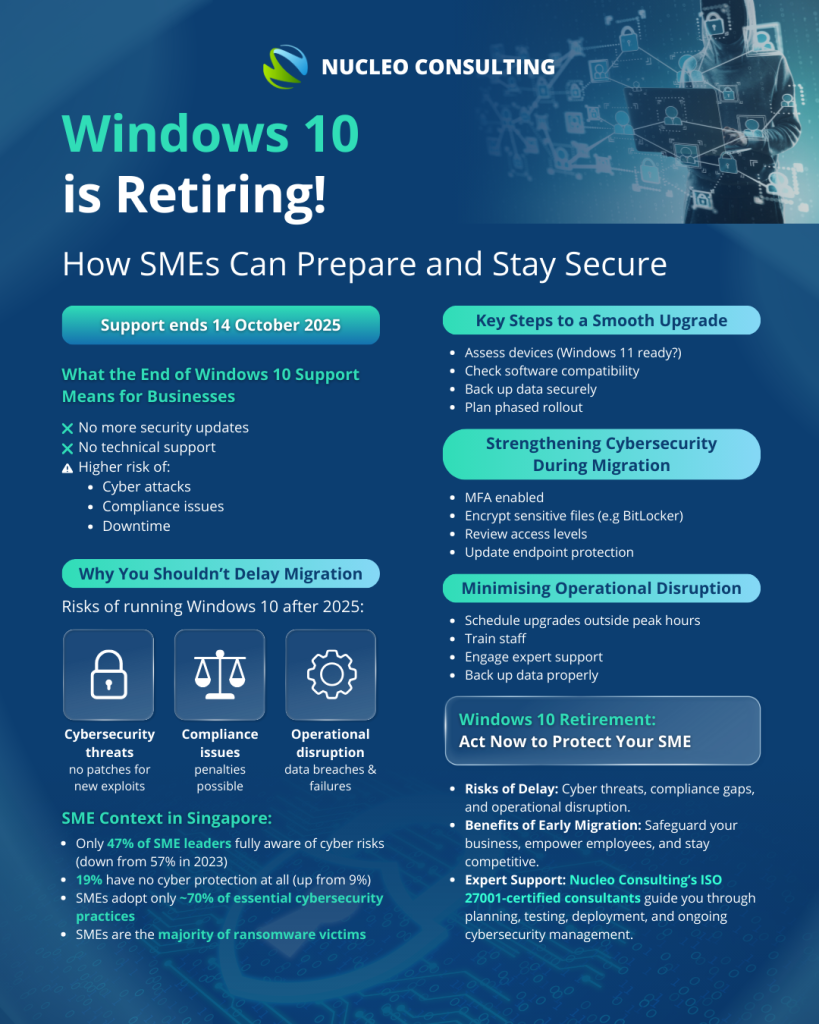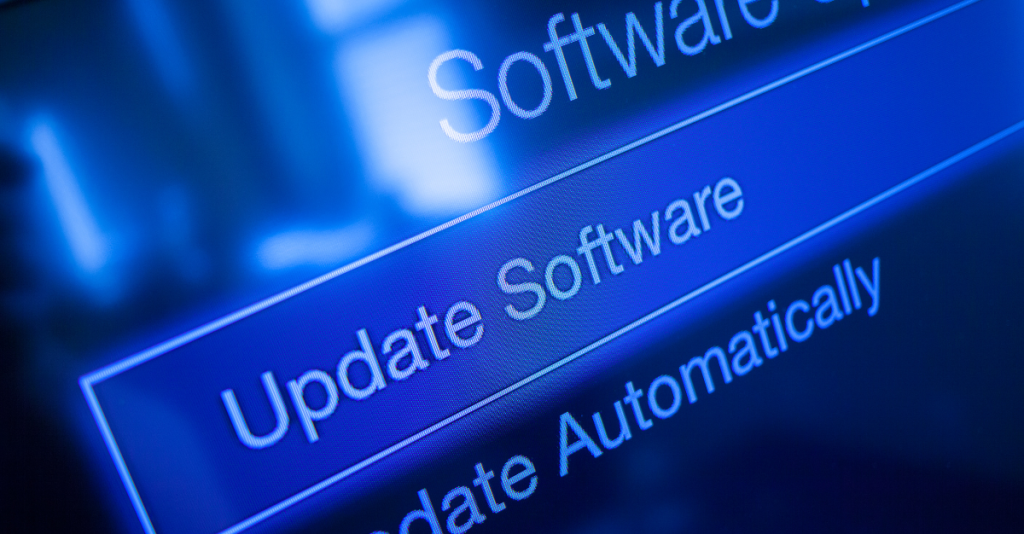
What the End of Windows 10 Support Means for Businesses
Microsoft has confirmed that support for Windows 10 will officially end on 14 October 2025. After this date, no new security updates, patches, or technical assistance will be provided. While devices running Windows 10 will still operate, the risks of cyberattacks, compliance failures, and costly downtime will increase significantly.
For SMEs in Singapore, this announcement is more than a technical update—it’s a business-critical moment. A smooth transition to Windows 11 isn’t just about keeping systems current, it’s about ensuring security, continuity, and competitiveness in an increasingly digital economy.
This article breaks down the risks of delaying migration, the steps SMEs should take to prepare, and how Nucleo Consulting can help you navigate this important shift.
1. Why You Shouldn’t Delay Migration

Running an unsupported operating system leaves SMEs exposed to:
- Heightened cybersecurity risks – With no security patches, cybercriminals can exploit vulnerabilities unchecked.
- Compliance concerns – Businesses in regulated sectors may face penalties if systems are outdated.
- Operational disruption – A data breach or system failure can halt operations and damage reputation.
In Singapore:
- A 2024 SME survey revealed that only 47% of SME leaders felt fully aware of potential cyber risks, a decline from 57% in the previous year.
- The same survey noted that 19% of SMEs had no protection in place against cyber risks, up from 9% the year before.
- The Cyber Security Agency of Singapore (CSA), in its Cybersecurity Health Report 2023, found that local organisations had implemented only about 70% of essential cybersecurity practices on average, leaving important gaps.
- CSA has also highlighted that SMEs account for the majority of victims in ransomware cases in Singapore, showing that smaller businesses are increasingly targeted.
These findings show that many SMEs remain vulnerable, and the end of support for Windows 10 will only intensify the risks.
For a deeper dive into SME vulnerabilities, see our article: Think Your Business Is Too Small for a Cyber Attack? Think Again.
2. Key Steps to a Smooth Upgrade
Migrating to Windows 11 doesn’t need to be disruptive—if you plan ahead. SMEs can take these steps now:
Assess device readiness
Check whether your existing hardware meets Windows 11 requirements (TPM 2.0, Secure Boot, processor, memory). Older devices may need replacement.
Review software compatibility
Test critical applications on Windows 11 to avoid last-minute surprises.
Back up important data
Ensure business data and configurations are securely backed up before migration begins.
Plan a phased rollout
Pilot test with non-critical systems, then expand to critical operations once stability is confirmed.
For SMEs unsure where to begin, our piece The SME’s Guide to Building a Long-Term IT Strategy explains how structured planning can make major transitions seamless.
3. Strengthening Cybersecurity During Migration
An OS upgrade is the perfect opportunity to reassess and reinforce your cybersecurity posture. Consider:
- Implementing multi-factor authentication (MFA).
- Encrypting sensitive files with tools like BitLocker.
- Reviewing user access levels to reduce insider risk.
- Updating endpoint protection and patching other software.
To explore why strong cybersecurity frameworks matter for SMEs, check out our feature: 5 Tech Mistakes That Are Costing You More Than You Think—And How to Fix Them.
4. Minimising Operational Disruption
Downtime during migration can be costly. To avoid this:
- Schedule upgrades outside peak hours to reduce business impact.
- Train staff on Windows 11 features so they adapt quickly.
- Engage expert support for large-scale rollouts to ensure minimal disruption.
- Back up data properly before making the switch—migration is one of the riskiest times for data loss if not planned carefully.
A robust backup strategy ensures that even if technical issues arise during migration, your critical business data remains safe. For a detailed look at why this is non-negotiable, see our article: Future-Proof Your Business: Why Investing in Nucleo Consulting’s Backup Solutions Are Essential for Long-Term Success.
Our article The Ultimate Guide to IT Consultancy for SMEs highlights how outsourcing IT expertise can help SMEs handle transitions like these smoothly and cost-effectively.
5. The Bigger Picture—Future-Proofing Your IT
Migrating to Windows 11 is not just a defensive move. It’s also about future-proofing your IT environment:
- Enhanced security features – Windows 11 includes stronger protections like hardware-based isolation and secure boot by default.
- Better performance – Improved speed, power management, and productivity tools.
- Longer-term compliance – Supported systems align with regulatory and contractual requirements.
Singapore’s national push for digitalisation means businesses that modernise now will be better positioned to embrace advanced solutions—whether that’s AI-driven automation, hybrid work systems, or cloud-first strategies.
For insights on aligning IT upgrades with broader business goals, see: Why Digital Transformation is Key for SMEs in Singapore.
Conclusion
The retirement of Windows 10 is a timely reminder: technology lifecycles are business lifecycles. Waiting until 14 October 2025 to act could leave your SME exposed to cyber risks, compliance gaps, and operational disruption.
By planning your migration now, you can safeguard your business, empower your employees, and stay competitive in Singapore’s fast-moving digital economy.
Nucleo Consulting’s ISO 27001-certified consultants are here to guide you through every step—from planning and testing to full deployment and ongoing cybersecurity management.
#SMEGrants #DigitalTransformation #CISOaaS #EEG #SingaporeSME #Cybersecurity #ITStrategy #GovGrantSG #ITSupport #NucleoConsulting